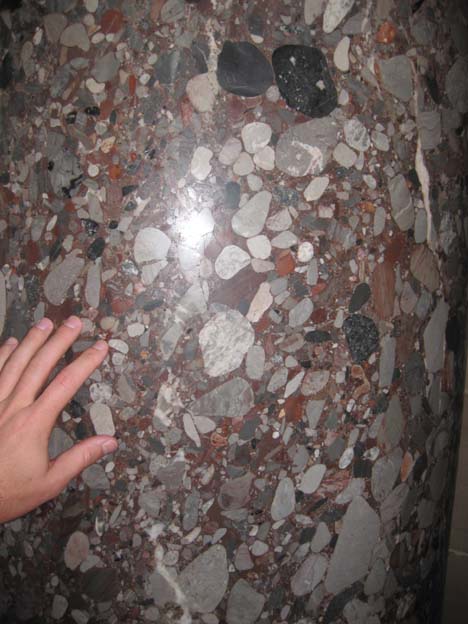My girlfriend’s mom was in town in January, and we took her down to visit the Capitol Building. The tour had a good bit of history, but definitely missed the opportunity to talk geology. I was particularly struck by the columns in the Hall of Statuary:

Close up of one column, with my hand for scale:

That’s the Leesburg Conglomerate, a Triassic-aged deposit found in the western part of the Culpeper Basin of Virginia. (Technically, it’s “the Leesburg Member of the Balls Bluff Siltstone.”) The photos I showed readers in May 2008 were from the east side of Route 15, just north of Leesburg itself. The Culpeper Basin is a failed rift valley from the time of Pangea’s breakup. I say “failed” in the sense that it failed to become an ocean basin like the Red Sea or the Labrador Sea. While it may have failed to rend the metamorphic rocks underlying Reston, Annandale, and D.C. from the North American continent, it succeeded in accumulating continental sediments for two periods of geologic time, preserving a detailed record written in siltstones, conglomerates, basalt flows, diabase intrusions, dinosaur footprints and fish fossils.
Among the strata that the basin accumulated, the Leesburg Conglomerate stands out as the real rock star. It’s a gorgeous looking rock, a poorly-sorted and well-oxidized mishmash of (mainly) limestone chunks derived from the weathering of the young Appalachian Mountains. Visually striking as it is, it’s not surprising that someone tried to use it as a building stone. However, it’s not well-suited to being sculpted. Rumor has it that after countless episodes of pebbles popping out of otherwise pristine, finished columns, the column-carver swore he would never touch this particular stone again. To my knowledge, the Capitol’s Hall of Statuary is the only place in the world where the Leesburg Conglomerate has been used as a building stone.

Callan,
Intriguing post. I have wondered about that stone. Do you know if people also call the Leesburg Conglomerate puddingstone, which is the name of a stone quarried near Boston? Also in response to your post, I put up a post about the puddingstone in Boston.
Cheers,
David
Yep, indeed that’s one of the many monikers for this stone.
The Leesburg Conglomerate is often referred to as a “fanglomerate” due to being alluvial fan deposits. There used to be an outcrop along Rt. 15 near White’s Ferry Rd. where you could see the contact between the L.C. and the underlying Balls Bluff Siltstone, showing how the alluvial fans prograded out into the lake. Unfortunately, VDOT, in its infinite wisdom, destroyed that part of the outcrop when they widened Rt. 15.
Bill, it’s good to see you out and about in the geoblogosphere! Good info; thanks!
Callan,
David Williams’ “Stories in Stone” blog sent me here. Your blog is excellent — I have put it in my GoogleReader and look forward to future posts.
Thanks to you both, for doing what you do.
Callan,
The “Stories in Stone” blog sent me here as well. This is a great post! The Leesburg (or whatever its equivalent is in Frederick, MD) was one of the first rocks I collected as a geology undergrad, because I also thought “Wow, this would look very pretty polished up”… and I did just that and made some trivets out of it. It’s one of my favorite rocks.
Ezra and Joe,
Welcome! I’ll have some more building stones posts coming up.
C